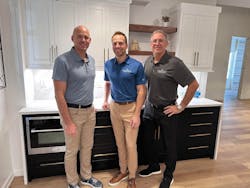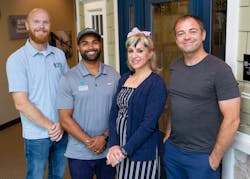A Blueprint For Business Success
In the summer of 2022, I made the transition from working for a replacement window company to covering the home improvement and remodeling industry for Pro Remodeler. I was immediately tasked with reaching out to design-build professionals and full-service remodelers for articles like this one.
I thought to myself: How different could design-build businesses be from exterior replacement contractors?
At first, they seemed worlds apart. The jargon was different. The business structure was different. And the disparity in the number of jobs sold every year was jarring.
To paraphrase my former employer and mentor, Energy Swing Windows’ President Steve Rennekamp, I didn’t know what I didn’t know.
A little more than a year later, I know some things thanks to the many remodelers who shared their stories.
Many remodelers have turned to business coaches to help them implement the systems and processes needed to scale their businesses.
One of those things is that despite some key differences, successful design-build businesses and home improvement contractors rely on many of the same core principles to guide growth. Here are some of the shared practices that standouts in these two segments have adopted to build a blueprint for business success.
Seek Help From Outside of Their Organization
Contractors who join industry associations and organizations with networking on national and regional levels have a distinct advantage over those who don’t: first-person learning of best practices from successful contractors.
Organizations like the National Association of Home Builders, Certified Contractors Network, and the National Association of the Remodeling Industry emphasize education and networking opportunities.
Many remodelers and home improvement contractors turn to business coaches to help them implement the systems and processes needed to scale their businesses and reach growth goals.
Jay Cope, CEO of Black Mountain, N.C.-based Semper Fi Custom Remodeling, sought help from a family friend who is a business coach for ActionCOACH.
“Our first year in business was pretty rough,” says Cope. “That’s when we decided to get some help and bring our friend on as our coach and consultant. Business has been awesome ever since.”
Semper Fi has grown from completing five to six jobs per year to approaching 50 projects in 2023. Cope says they have plans to double in size by the end of 2024, and he attributes much of their success to their processes.
“Our business coach taught us to systemize the routine and humanize the exception,” says Cope. “If something should be done the same way every time, it should be systemized.”
Roswell, Ga.-based Ranney Blair Weidmann Remodeling hired Kyle Hunt of Remodelers on the Rise as its business coach. Co-Founder and Managing Partner Peter Ranney says the initial goal of hiring Hunt was to focus on improving three key areas: marketing, sales, and job costing.
“Kyle’s a really good coach,” says Ranney. “Hiring him was the key to our growth.”
Ranney Blair Weidmann’s business revenue is projected to reach $7.5 million by the end of 2024 and the company’s five-year plan includes revenue goals of up to $15 million.
Home improvement companies also benefit from business coaching, which can extend past leadership.
Opal Enterprises Co-Owner Tara Dawn brought home improvement sales guru Charlie Gindele of Certified Contractors Network into her business to train her sales team.
“Charlie is a legend because he’s gotten proven results,” says Dawn. “He spent three full days with our sales team and trained them through role-playing.”
Opal Enterprises, which reached $10 million in revenue in 2022, provides replacement window, door, and siding installation out of two locations in Naperville and Des Plaines, Ill. Dawn’s next goal is to open additional locations.
Avoid Trying to Be Everything to Everybody
Before becoming a business coach to home improvement companies like Opal Enterprises, Charlie Gindele was a successful entrepreneur in the replacement window and door space.
After 38 years in the industry and amassing more than $425 million in revenue, Gindele sold his Renewal by Andersen of Orange County business in 2021.
Through books and speaking engagements, he shares the keys to achieving accelerated growth, many of which he didn’t learn and implement until after 28 years in business.
In 2012, Gindele’s business began growing at a compound annual rate of 25% all the way to $47 million in revenue by 2021.
One reason for his success was cutting back on the product categories he offered, from 10 to just two.
“A lot of remodeling and home improvement companies try to be all things to all people,” says Gindele. “Instead, they should narrow their focus to one area and get good at marketing that.”
Gindele stopped offering roofing, siding, and gutters, among other products, and started focusing exclusively on windows and doors. And he raised his prices.
“Generally, to be successful in one of these businesses, you’re going to have to be the most expensive or one of the most expensive companies in your market,” claims Gindele.
Another way to narrow one’s focus is to only go after jobs of a certain size.
Peter Ranney says in the early stages of their business, they would take on just about any job. It wasn’t until they focused on the build piece of their business that they began to grow.
Ranney Blair Weidmann Remodeling brought design in-house and hired their first designer in 2020, which led them to begin targeting large-scale projects, such as whole-home remodels and additions.
While many competitors refuse to bid on projects that exceed a certain scope, Ranney Blair Weidmann actively pursues big jobs to great benefit.
“Our average ticket last year was around $275,000,” says Ranney. “This year, we’re tracking closer to $400,000 per job. We want the big stuff. We’re searching for the whales.”
Recognize Marketing As The Lifeblood of Their Business
Gindele and Cope share the belief that most in their fields get into business because they are experts in the technical aspects of their trades. They also believe the sooner a business owner realizes the importance of marketing, the sooner they achieve success.
Cope says the customer base in his market includes a high number of people who move often and don’t know their neighbors very well, making referrals more challenging.
In addition to focusing on search engine optimization (SEO) and social media marketing, Semper Fi implemented a process for requesting clients to leave Google reviews.
“It seems super obvious, but at the end of each job, we ask if we can get a five-star Google review,” says Cope. “Just by doing this, our Google reviews have gone way up.”
Gindele says the nature of home improvement businesses means that there’s not a lot of residual income. He calls marketing and lead generation the most essential part of a business.
“Leads are like oxygen,” says Gindele. “You can’t hang in there too long without oxygen, and home improvement businesses can’t hang in there very long without steady, consistent lead flow.”
It may be obvious that companies need to spend their marketing dollars effectively and efficiently, but Gindele also warns against home improvement companies spending too little on marketing.
“You can’t spend three or 4% of your revenue on marketing and have a growing business,” he says. “You should plan to spend at least 8%. Companies that are really growing are spending 10 to 15% on marketing.”
A Teachable and Repeatable Sales Process
When Semper Fi started to develop systems and processes, their business coach singled out the lack of a sales process as the primary reason for their lackluster revenue.
“We were all over the place,” says Cope. “We were losing out on a lot of jobs. Our conversion rates were poor because we didn’t have a standard sales process to follow.”
They developed a process that featured several “wow” factors and required a minimum number of touches and follow-ups designed to drastically increase their chance of sales success.
Their sales process continues to evolve as they tackle larger projects.
“Kitchens and baths were our bread and butter for years,” says Cope. “But we’ve seen a huge surge in $500,000 to $700,000 whole-home remodels and [primary] suite additions that require much more technical detail and added steps to our process.”
By the time Gindele was ready to sell his replacement window and door business in 2021, he had grown his operation to three sales managers overseeing a total of 32 sales reps. He cites a comprehensive training program and a process as the key contributors to his sales success.
“You’ve got to have a sales process that is teachable, trainable, repeatable, and perfectible,” states Gindele. “And you’ve got to have sales meetings where you practice role-playing with your reps.”
These business leaders agree that developing and following processes is required to deliver top-notch customer experiences.
A significant step in Gindele’s sales process was the one-call close.
While some inside the industry still consider the one-call close a high-pressure tactic, Gindele says closing the sale on the first visit is the natural conclusion to an effective presentation that results in the homeowner getting what they want at a price they feel is fair.
“If you have the products, specifications, and workmanship they want—and you’re the company they want—then you can give them an additional financial incentive to buy today,” says Gindele. “The customers who move forward the first day actually save you time and money and allow you to meet with more customers.”
Prior to implementing this sales process, Gindele says 40% of their sales were closed on the first visit. After installing the one-call close into his strategy, 97% of the jobs his company sold were sold on the first visit.
Emphasize Structured and Productive Meetings
Meetings get a bad rap because they’re often disorganized, redundant, and unproductive. But they don’t have to be that way. Most successful contractors consider meetings integral to their success.
Ranney Blair Weidmann Remodeling’s Co-Founders Peter Ranney and Scott Blair have implemented the Entrepreneurial Operating System (EOS) into their business. EOS describes itself as, “a people operating system that harnesses human energy through a simple set of tools and principles.”
One of the principles of EOS that has helped their business the most is the Level 10 Meeting (L10). L10 Meetings are highly structured 90-minute weekly meetings designed to focus on the most important issues facing your business. These meetings are held at the same time on the same day every week—10:00-11:30 every Friday morning for Ranney Blair Weidmann.
Ranney considers components of the meetings called “Rock Review” and “Identify, Discuss, Solve” (IDS) as the most impactful. Each member of their team is responsible for achieving a quarterly goal, or rock, for the greater good of the company. Five minutes of every L10 Meeting are dedicated to employees sharing whether they are on or off track to accomplish their goals. Any issues related to the rock or other items are addressed during the 60-minute IDS portion of the meeting.
“The L10 meetings really allow us to hone in on the issues and give us time to discuss and solve them,” says Ranney. “The meeting structure is most important because it creates consistency around start and end times and what we’re going to go over to move our business forward.”
External meetings can be equally effective at driving business growth if organized with purpose.
Semper Fi requires weekly meetings between its project managers and each customer to ensure everyone remains on the same page as it relates to budget, schedule, product selection, and miscellaneous concerns that may arise.
“The biggest benefit of these meetings is that they prevent projects from being in the red because balls aren’t being dropped,” says Jay Cope. “They last about an hour and make homeowners feel like they’re being taken care of.”
The Result: First-Class Customer Experiences
The aforementioned principles are only a portion of the similarities involved in running successful remodeling and home improvement businesses.
These business leaders agree that developing and following processes is a necessity for delivering top-notch customer experiences.
“We added a lot of processes and systems specifically tailored to customer satisfaction,” says Cope. “We believe that what we’re really selling is an experience.”
Peter Ranney echoes this sentiment.
“We want to provide a dynamic and customized experience to our clients,” says Ranney. “If we do that, we’ll get jobs and we’ll reach our revenue goals.”









